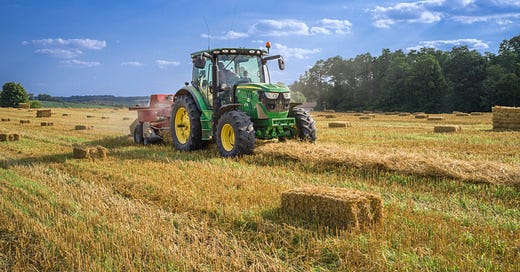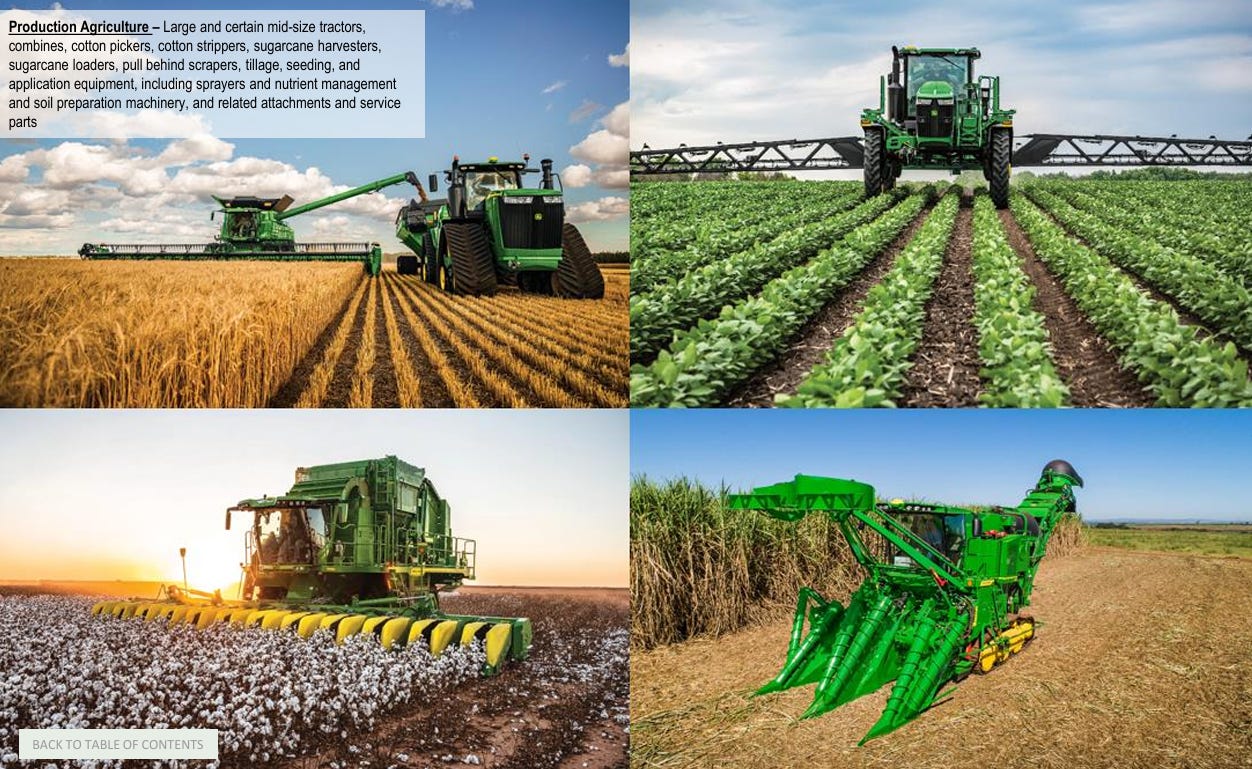Deere & Co, Towards Less Cyclicity
Opportunities and risks of a huge business model transformation
While Deere & Co is well-known for its products and has garnered a substantial user community, its transformation towards a more service-oriented business model is particularly intriguing. How far will they go in this transformation? Will they become less cyclical? This shift presents significant opportunities as well as substantial risks.
Let’s explore the company and assess its future potential.
Company overview
The company is a global leader in the manufacturing of agricultural, construction, and forestry machinery. Deere & Co’s is divided into four divisions (Production & Precision Agriculture, Small Agriculture & Turf, Construction & Forestry, and Enabling Businesses) to answer a wide range of customer needs.
Production & Precision Agriculture - 43% of the sales
The Production & Precision Agriculture division focuses on large-scale agricultural equipment and advanced technology solutions designed for efficient and precise farming operations. This division offers tractors, advanced combine harvesters, specialized planters, seeders, sprayers (for fertilizers and pesticieds).
This division is enhanced with solutions such as GPS, automation, data, software, remote monitoring to improve efficiency for customers.
Small Agriculture & Turf - 23% of the sales
The Small Agriculture & Turf division focuses to smaller-scale agricultural operations, residential customers, and commercial landscape maintenance businesses. This division provides versatile compact tractors suitable for small farms and properties, multi-purpose utility vehicles for various tasks, and mowers for residential and commercial use.
Additionally, it offers turf equipment like aerators, seeders, and mowers for lawn care, as well as residential lawn care solutions.
Construction & Forestry - 23% of the sales
The Construction & Forestry division focuses on heavy equipment for the construction, forestry, and road-building industries. This division manufactures hydraulic excavators, wheel and track loaders for material handling, bulldozers for earth-moving and grading, and motor graders for road construction and maintenance.
In forestry, it offers a range of equipment including feller bunchers, harvesters, skidders, forwarders, delimbers, and processors designed for timber extraction and processing.
Enabling Businesses - 11% of the sales
The Enabling Businesses division supports Deere & Co's core operations by providing essential services and infrastructure that enhance the overall value proposition of the company’s products and services. This division offers financial services (financing, leasing, and insurance solutions)
It ensures the availability of spart parts and maintenance services. Additionally, the division drives technological innovation by developing and integrating technologies (IoT, AI, and automation). It also helps the dealer network with training resources and tools to improve customer service.
Geographical breakdown
Most of Deere & Co's sales occur in North America, accounting for 60% of total revenue. In contrast, Central and Western Europe represent less than 20% of sales. This gap is understandable given the significant differences in agricultural practices between the regions. U.S. agriculture is highly industrialized, operating on a scale that is often difficult for the Europeans to understand.
An ambitious strategic plan
The current strategic plan is named LEAP. Its aims to transform Deere & Co into a more productive, more profitable, and more sustainable company. They want to increase the delivered value to customers.
By 2026, the goal is to connect most of the machines and develop alternative power solutions to reduce carbon emissions.
The more interesting is the development towards a Solutions As a Service business model. It will allow lower up-front costs and customers to only pay for what they use. More importantly, it will create recurring revenue, reinforce moat, reduce volatility and optimize resource use.
The primary goal is to achieve 10% recurring revenue by 2030, marking a significant transformation in Deere & Co.'s business model. This shift presents a substantial opportunity, as recurring revenue could greatly enhance the company's financial stability. However, like any major transformation, it comes with risks, including challenges in execution, potential market reactions, and increased competition. Given these uncertainties, it would be prudent not to fully factor the anticipated success of this transformation into the company's current valuation, as it remains a distant objective.
Competitive landscape
Deere & Co owns around 25% of the global agriculture machinery market. In most regions, the market is very concentrated.
To have a good idea of the competition, I will use my scoring system. This will allow to identify the strengths and weaknesses of each companies. Of course, this should be seen as a reference only.
Keep reading with a 7-day free trial
Subscribe to Quality Stocks to keep reading this post and get 7 days of free access to the full post archives.








